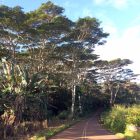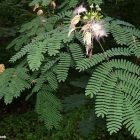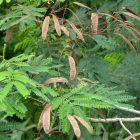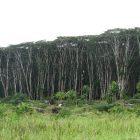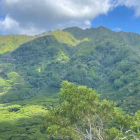Albizia
ALBIZIA (FALCATARIA MOLUCCANA)
- Hawaiʻi Pacific Weed Risk Assessment: High Risk

- Regulatory Status: No existing Laws or Regulations regarding the use or planting of Albizia
- What You Can Do to remove Albizia including alternative landscaping options on Plant Pono {See Below}
- Report this species if seen on Molokai
{Click Tabs} DESCRIPTIONIMPACTSERADICATION & CONTROL METHODSWHAT YOU CAN DO• Albizia is large tree that can grow up to 150ft. tall
• Extremely fast growing, up to 15 ft per year (possibly the fastest growing tree in the world)
• Its brittle limbs are prone to “sudden branch drop,” where branches suddenly fall without warning
• Produces large numbers of seeds/pods easily dispersed by the wind
• Capable of altering the entire natural native Hawaiian ecosystem
• Albizia’s extraordinary growth rate combined with its significant seeding capabilities can lead to a dense canopy of trees that can prevent the growth of native Hawaiian forest plants and trees
• Quality bird habitat is diminished when Albizia choke out native trees and forests
• Its brittle nature leads to sizable fallen trees and limbs which can block roads and waterways
• Additionally, its sizable fallen trees and limbs can cause damage to housing/property, and public infrastructure, including damage to utilities potentially leading to power outages
• Large more mature trees are costly to remove potentially costing thousands of dollars
• Albizia trees can quickly spread into and take over farms, grasslands, and freshly cleared areas
• Albizia trees change soil composition (by adding excess nitrogen) which inhibits growth of native forests
• BIISC Target Species
• MoMISC Target Species
• HISC advises against planting and Plant Pono provides Landscaping Alternatives
• DO NOT PLANT
• Report to 643-Pest and 643Pest.org if found on Molokai
• Removal can be cheap and easy when trees are juvenile, but waiting can until maturity can be costly (thousands of dollars). •Background and tips to control Albizia from the O’ahu Invasive Species Committee and the Big Island Invasive Species Committee (FAQs and Pamphlet) :
• A certified arborist can be contracted to help you remove Albizia from your property, and BIISC advises to contact the USDA Rural Development office in Hilo for more information on offers low-cost loans and grants for removal assistance.
DESCRIPTIONIMPACTSERADICATION & CONTROL METHODSWHAT YOU CAN DO
• Albizia is large tree that can grow up to 150ft. tall
• Extremely fast growing, up to 15 ft per year (possibly the fastest growing tree in the world)
• Its brittle limbs are prone to “sudden branch drop,” where branches suddenly fall without warning
• Produces large numbers of seeds/pods easily dispersed by the wind
• Extremely fast growing, up to 15 ft per year (possibly the fastest growing tree in the world)
• Its brittle limbs are prone to “sudden branch drop,” where branches suddenly fall without warning
• Produces large numbers of seeds/pods easily dispersed by the wind
• Capable of altering the entire natural native Hawaiian ecosystem
• Albizia’s extraordinary growth rate combined with its significant seeding capabilities can lead to a dense canopy of trees that can prevent the growth of native Hawaiian forest plants and trees
• Quality bird habitat is diminished when Albizia choke out native trees and forests
• Its brittle nature leads to sizable fallen trees and limbs which can block roads and waterways
• Additionally, its sizable fallen trees and limbs can cause damage to housing/property, and public infrastructure, including damage to utilities potentially leading to power outages
• Large more mature trees are costly to remove potentially costing thousands of dollars
• Albizia trees can quickly spread into and take over farms, grasslands, and freshly cleared areas
• Albizia trees change soil composition (by adding excess nitrogen) which inhibits growth of native forests
• Albizia’s extraordinary growth rate combined with its significant seeding capabilities can lead to a dense canopy of trees that can prevent the growth of native Hawaiian forest plants and trees
• Quality bird habitat is diminished when Albizia choke out native trees and forests
• Its brittle nature leads to sizable fallen trees and limbs which can block roads and waterways
• Additionally, its sizable fallen trees and limbs can cause damage to housing/property, and public infrastructure, including damage to utilities potentially leading to power outages
• Large more mature trees are costly to remove potentially costing thousands of dollars
• Albizia trees can quickly spread into and take over farms, grasslands, and freshly cleared areas
• Albizia trees change soil composition (by adding excess nitrogen) which inhibits growth of native forests
• BIISC Target Species
• MoMISC Target Species
• HISC advises against planting and Plant Pono provides Landscaping Alternatives
• MoMISC Target Species
• HISC advises against planting and Plant Pono provides Landscaping Alternatives
• DO NOT PLANT
• Report to 643-Pest and 643Pest.org if found on Molokai
• Removal can be cheap and easy when trees are juvenile, but waiting can until maturity can be costly (thousands of dollars). •Background and tips to control Albizia from the O’ahu Invasive Species Committee and the Big Island Invasive Species Committee (FAQs and Pamphlet) :
• A certified arborist can be contracted to help you remove Albizia from your property, and BIISC advises to contact the USDA Rural Development office in Hilo for more information on offers low-cost loans and grants for removal assistance.
• Report to 643-Pest and 643Pest.org if found on Molokai
• Removal can be cheap and easy when trees are juvenile, but waiting can until maturity can be costly (thousands of dollars). •Background and tips to control Albizia from the O’ahu Invasive Species Committee and the Big Island Invasive Species Committee (FAQs and Pamphlet) :
• A certified arborist can be contracted to help you remove Albizia from your property, and BIISC advises to contact the USDA Rural Development office in Hilo for more information on offers low-cost loans and grants for removal assistance.
For more information
- The Hawaiʻi Invasive Species Committee released an Albizia Strategic Plan in 2018 to minimize the impacts of Albizia on the environment, human health, and infrastructure
- Video footage of Albizia from Hurricane Iselle in 2014
- Stages of Growth pamphlet from the Ko’olau Watershed.
- History and Background and why not-to-plant on the PlantPono
- Potential Uses of Albizia
- https://locals.hawaiiverse.com/albizia-turning-big-islands-most-hated-tree-into-something-beautiful/
- https://www.hawaiibusiness.com/albizia-project/
- Forestry & Wildlife Albizia StoryMap
- Pending State Legislation
- Look Alikes: None.



